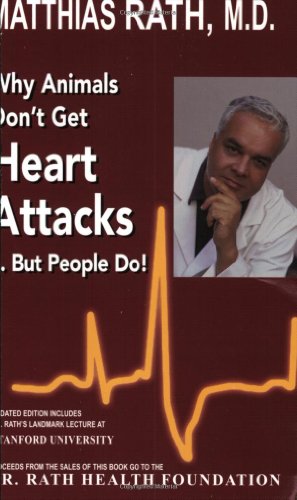Researchers claim they have found why humans, but not other animals, are prone to heart attacks. News reports of this discovery are confusing because they errantly infer a gene mutation (CMAH gene), which eliminates internal synthesis of a sugar-like molecule called Neu5Gc (aka sialic acid), is what makes humans vulnerable to chronic inflammation that can lead to cancer and heart attacks.
Actually the inactivation of the CMAH gene via a gene mutation, which occurred long ago in human history, eliminated endogenous production of this toxic Neu5Gc molecule in humans. That would represent a health-positive gene mutation, not a negative health mutation as some confused news reports maintain. The initial scientific discovery is published in the July 22, 2019 issue of the Proceedings of the National Academy of Sciences.
 Curing the Incurable: ...
Best Price: $22.60
Buy New $18.89
(as of 08:55 UTC - Details)
However, humans may eat meat from animals that do produce Neu5Gc and this is at least a partial reason why red meat consumption has been repeatedly linked to heart attacks. Caviar (fish eggs) has the highest amount of Neu5Gc but is not consumed as often as red meat. According to one study, red meat contains 25-231 micrograms of Neu5Gc per gram of meat; caviar 445-530 micrograms per gram. If mice are fed Neu5Gc they develop 2.4 times more plaque in their arteries.
Curing the Incurable: ...
Best Price: $22.60
Buy New $18.89
(as of 08:55 UTC - Details)
However, humans may eat meat from animals that do produce Neu5Gc and this is at least a partial reason why red meat consumption has been repeatedly linked to heart attacks. Caviar (fish eggs) has the highest amount of Neu5Gc but is not consumed as often as red meat. According to one study, red meat contains 25-231 micrograms of Neu5Gc per gram of meat; caviar 445-530 micrograms per gram. If mice are fed Neu5Gc they develop 2.4 times more plaque in their arteries.
The Vitamin C Connection
There is evidence that Neu5Gc is incorporated into the synthesis of chondroitin sulfate, a component of connective tissue. Chondroitin is internally produced in the body and is an integral component in joints and arteries. Supplemental chondroitin sulfate has been demonstrated to lower the risk for mortal heart attacks. Vitamin C is a stimulant of chondroitin and collagen within connective tissue.
The untold story is that animals genetically engineered to NOT produce vitamin C internally experience a dramatic and rapid increase in Neu5Gc (sialic acid) within 21 days!
Here are the blood plasma levels of Neu5Gc (sialic acid) among genetically engineered laboratory rats that do NOT internally synthesize vitamin C and were fed a vitamin-deficient diet, as reported in 1998:
Control animals: 28.0 nanomole concentration per milligram of protein
Vitamin C deficient animals: 38.4
Vitamin C + E deficient animals 40.6
Modern medicine is not connecting the dots. That GULO gene mutation, which nixed the synthesis of an enzyme (gulonolactone oxidase) that converts blood sugar (glucose) to ascorbate (vitamin C), is what causes a dramatic rise in Neu5Gc/sialic acid, not just dietary sources of Neu5Gc from red meat. The vitamin C link to heart attacks remains obscure, ridiculed and dismissed by modern medicine and hidden from the masses.
Knowledge of this flawed GULO gene has been archived in the medical literature since the 1970s. The consumption of red meat has been repeatedly linked to heart attacks, cancer, and other inflammatory problems. Noted vitamin researchers Matthias Rath along with Nobel prize laureate Linus Pauling published animal experiments in 1990 that showed guinea pigs, like humans, do not internally synthesize vitamin C and accumulate atherosclerotic plaque and a buildup of a form of cholesterol — lipoprotein(a) – that can result in a blockage of coronary arteries (a heart attack). Dr. Rath also wrote a book entitled WHY ANIMALS DON’T GET HEART ATTACKS BUT PEOPLE DO.
Humans are universally affected by the gene mutation (GULO gene) that blocks the internal production of vitamin C. Many, many generations ago humans endogenously produced vitamin C on a 24/7 basis by conversion of blood sugar (glucose) to ascorbate (vitamin C). Modern humans must totally rely upon the diet to meet their need for vitamin C. In the 1970s Biochemist Irwin Stone estimated unstressed humans need 1800-4000 milligrams of oral vitamin C/day to make up for this gene mutation.
 Why Animals Don’...
Best Price: $1.48
Buy New $40.35
(as of 08:10 UTC - Details)
Why Animals Don’...
Best Price: $1.48
Buy New $40.35
(as of 08:10 UTC - Details)
Public health authorities recommend only 60-200 milligrams of vitamin C/day, preventing overt symptoms of scurvy (bleeding gums, lassitude, hemorrhage, shortness of breath, curly/dry hair, bone pain, poor wound healing, depressed mood) but leaving the gene mutation only partially corrected.
Animals in the wild, except for guinea pigs, fruit bats, kill fish and primate monkeys that have the same gene mutation as humans, internally produce many thousands of milligrams of vitamin C per day when undergoing mental or physical stress. Vitamin is in acute demand during hours of sleep when the body is under repair, precisely when it is impossible to take vitamin C. Vitamin C as a water-soluble nutrient is rapidly excreted in urine flow and half of it is excreted in 30 minutes.
A modern effort to restore internal 24/7 vitamin C synthesis in humans has been launched by this author and has been scientifically explained. Early studies with nutritional therapy have been consistent with the restoration of vitamin C as evidenced by elevated levels of vitamin C in urine and blood samples. (See chart below):
This pilot human study reveals a nutraceutical was able to dramatically increase vitamin C blood levels without the consumption of vitamin C-rich foods or dietary supplements.





